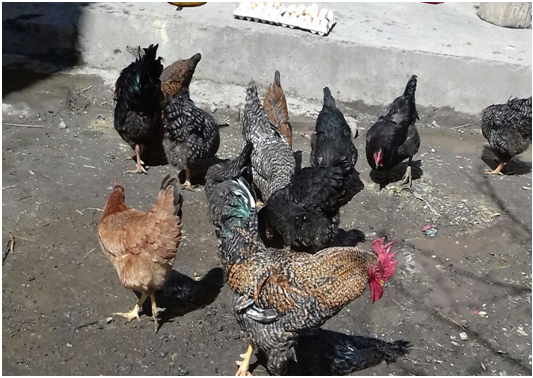
Indian poultry industry has made tremendous and remarkable progress evolving from small-scale backyard venture to the status of full-fledged, self-sufficient, and most progressive agro-based industry. It ranks 3rd in egg production and 5th in broiler production in the world. The poultry industry in India is well organized. Backyard poultry farming is the main enterprise of rural areas of the country. Out of the total poultry population, 30% are reared under the backyard poultry system.
Backyard poultry keeping is an age-old practice of the rural families who are in the bottom of the socio-economic ladder, commonly the schedule cast and schedule tribe families. They keep 10-15 no. of bird in their courtyard/backyard and rear them under scavenging conditions. The birds in the backyard exhibit their natural behavior like the fluttering of wings, scratching of floor, sunbathing, dust bathing, eating greens, and scuffing for insects, shells, grit, etc. Kitchen waste remains the main source of feed for the birds. The most preferred quality chicken and egg come from this sector, which is sold at a premium market price. Backyard poultry also contributes the main source of nutrition of the poor population of rural India.
Backyard poultry farming is less labour intensive and is easy to establish in rural areas because of low input costs. These birds are disease resistant and disease management is not an issue in the traditional areas. It provides income to a large number of people in rural areas especially women folk. This sector plays an important role in the socioeconomic up-liftmen of the rural mass. Backyard Poultry can act as an engine for economic growth through the eradication of rural poverty. The farmers practicing this sort of farming earn a good amount of money from the adjoining areas where they sell their birds and eggs. Most of the backyard poultry production comprises the rearing of indigenous birds with poor production performances. Unfortunately, poor farm women have maintained local desi poultry strains, with traditional management, having low productivity and low level of income. The potentiality of indigenous birds in terms of egg production is only 90 to 100 eggs/ bird/ year and meat production is also very less that is 1-1.5kg per bird. The slow growth, less egg production, and small-sized egg from the indigenous strain make the people less profitable from backyard poultry rearing. In spite of their low productivity, desi birds are continued to be reared by rural families for a variety of reasons:
- It is a low-cost vocation practiced for centuries in villages in the region with virtually no input costs.
- Feed cost is negligible due to better utilization of agricultural by-products, leftover feed, kitchen waste, vegetable scraps and grains.
- Boost up in family income for better utilization of family laborers who are not able to perform other agricultural works like old family member or children.
- Quality of chicken and egg is better in terms of organic farming as the birds are raised in stress less environment with natural input.
- These birds are diseases resistant and disease management is not an issue in the traditional area of the region.
- The birds also serve as safety kits for financially starved rural families and are sold during emergencies to get cash-in-hand.
- There is a separate market segment for meat and eggs from rural poultry reared under free-range conditions. Multi-colour desi birds and their brown-shelled eggs still fetch premium prices in the local markets in India.
However, the backyard poultry production can easily boost up with improved varieties of poultry breeds for more meat and egg production. To improve the socio-economic status of the traditional farmers, there is a need to popularize backyard poultry farming with an improved strain of poultry birds such as (Vanraja, Kroiler, Gramapriya, etc), who perform an excellent result when raised in the backyard with low input. Vanraja and Kroiler give more eggs (180-200 egg/ bird/ year) and more meat yield (mature body weight 3.5 to 4.5 kg meat/bird), compared to local birds which produce (80-100 egg/bird/year) and (1-1.5kg meat/bird) respectively. The rural poultry owners had poor knowledge about feeding, breeding, and management practice, which led to poor performance of the birds. Therefore, extension programmes in backyard poultry farming should commensurate so that the poultry owners become more knowledgeable and skillful about the new technologies as well as the recommended practices and can maximize productivity and consequently the income.

Dr. Nazir Ahmed, Dr. Maria Abbas, and Dr. MirRovida
F.V.Sc & A H. Shuhamadgam, SKUAST-K
*Corresponding Author animaldr2@gmail.com



























